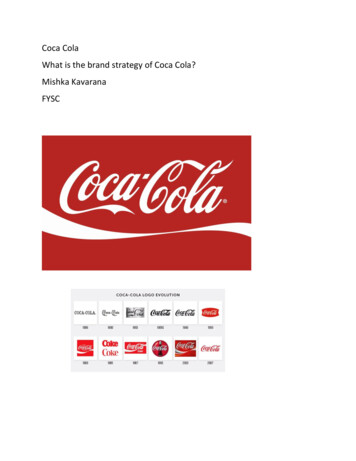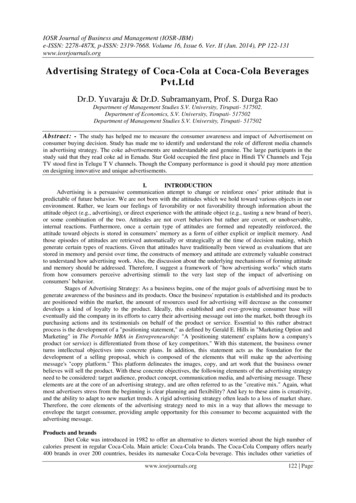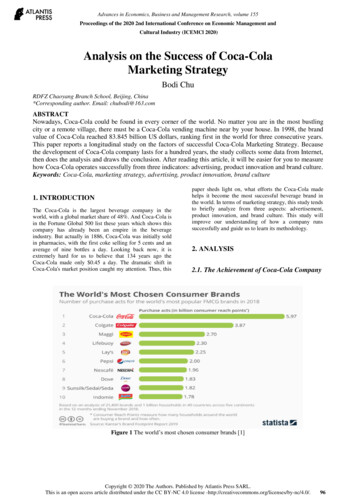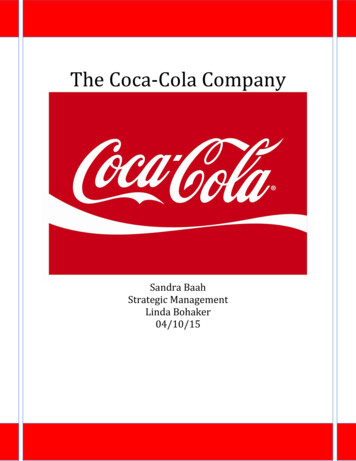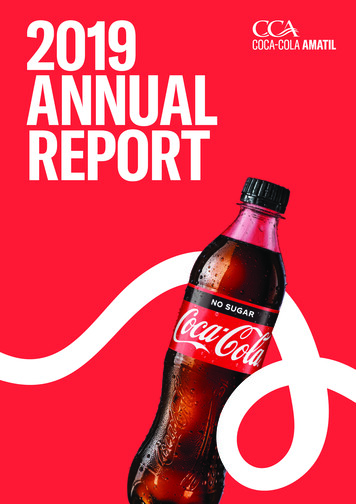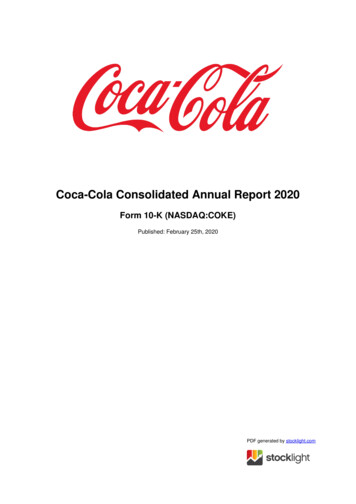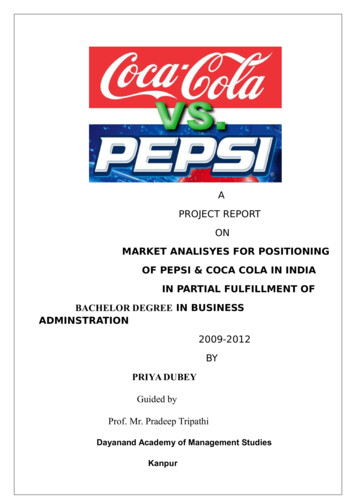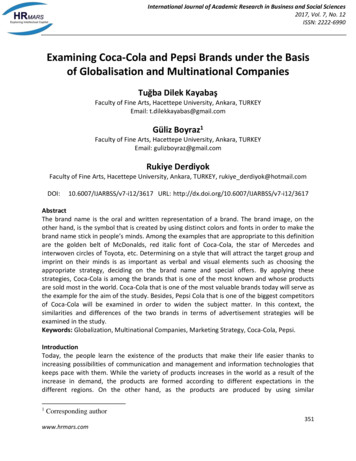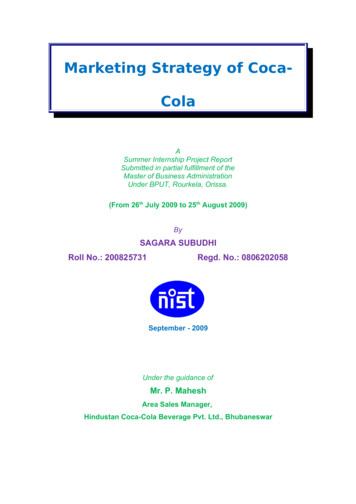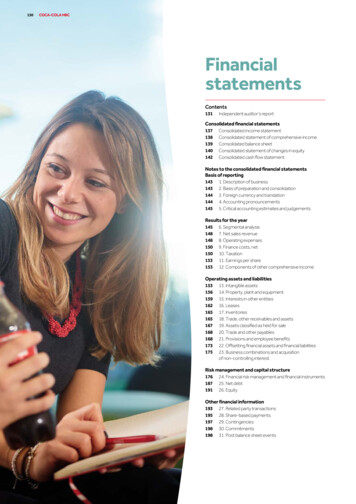
Transcription
130COCA-COLA HBCFinancialstatementsContents131Independent auditor’s reportConsolidated financial statements137138139140142Consolidated income statementConsolidated statement of comprehensive incomeConsolidated balance sheetConsolidated statement of changes in equityConsolidated cash flow statementNotes to the consolidated financial statementsBasis of reporting1431431441441451. Description of business2. Basis of preparation and consolidation3. Foreign currency and translation4. Accounting pronouncements5. Critical accounting estimates and judgementsResults for the year1451481481501501531536. Segmental analysis7. Net sales revenue8. Operating expenses9. Finance costs, net10. Taxation11. Earnings per share12. Components of other comprehensive incomeOperating assets and liabilities15315615916216516516716816817317513. Intangible assets14. Property, plant and equipment15. Interests in other entities16. Leases17. Inventories18. Trade, other receivables and assets19. Assets classified as held for sale20. Trade and other payables21. Provisions and employee benefits22. Offsetting financial assets and financial liabilities23. Business combinations and acquisitionof non‑controlling interestRisk management and capital structure17618719124. Financial risk management and financial instruments25. Net debt26. EquityOther financial information19319519719819827. Related party transactions28. Share-based payments29. Contingencies30. Commitments31. Post balance sheet events
INTEGRATED ANNUAL REPORT 2019131SRCGIndependent auditor’s reportFSSSRIndependent auditor’s report to Coca-Cola HBC AGReport on the audit of the consolidated financial statementsOpinionIn our opinion: Coca-Cola HBC AG’s (‘Coca-Cola HBC’ or the ‘Group’) consolidated financial statements (the ‘financial statements’) give a true and fair viewof the state of the Group’s affairs as at 31 December 2019 and of its profit and cash flows for the year then ended; and have been properly prepared in accordance with International Financial Reporting Standards (‘IFRSs’) as issued by the International AccountingStandards Board (‘IASB’).We have audited the financial statements, included within the 2019 Integrated Annual Report (the ‘Annual Report’), which comprise: the consolidatedincome statement and the consolidated statement of comprehensive income for the year ended 31 December 2019, the consolidated balancesheet as at 31 December 2019, the consolidated statement of changes in equity and the consolidated cash flow statement for the year ended31 December 2019, and the notes to the financial statements, which include a description of the significant accounting policies.Our opinion is consistent with our reporting to the Audit & Risk Committee.Basis for opinionWe conducted our audit in accordance with International Standards on Auditing (‘ISAs’). Our responsibilities under ISAs are further describedin the Auditor’s responsibilities for the audit of the financial statements section of our report. We believe that the audit evidence we have obtainedis sufficient and appropriate to provide a basis for our opinion.IndependenceWe remained independent of the Group in accordance with the ethical requirements that are relevant to our audit of the financial statements,which include the International Ethics Standards Board for Accountants’ Code of Ethics for Professional Accountants (‘IESBA Code’). We havefulfilled our other ethical responsibilities in accordance with the IESBA Code and other applicable laws and regulations.To the best of our knowledge and belief, we declare that non-audit services prohibited by the IESBA Code and other applicable laws andregulations were not provided to the Group.Other than those disclosed in Note 8 of the Annual Report, we have provided no non-audit services to the Group in the period from 1 January2019 to 31 December 2019.Our audit approachOverview Overall group materiality: 33.0 million (2018: 30.5 million)MaterialityAudit scopeKey auditmatters We audited the complete financial information of the Company and of subsidiary undertakingsin 15 countries. Taken together, the undertakings of which an audit of their complete financial information was performedaccounted for 84% of consolidated net sales revenue, 89% of consolidated profit before tax and 87%of consolidated total assets of the Group. We also conducted specified audit procedures and analytical review procedures for other subsidiaryundertakings and Group functions. Goodwill and indefinite-lived intangible assets valuation. Uncertain tax positions. Provisions and contingent liabilities.SI
132COCA-COLA HBCIndependent auditor’s report continuedThe scope of our auditAs part of designing our audit, we determined materiality and assessed the risks of material misstatement in the financial statements.Capability of the audit in detecting irregularities, including fraudBased on our understanding of the Group and industry in which it operates, we considered the extent to which non-compliance with applicablelaws and regulations might have a material effect on the financial statements, including, but not limited to, the Listing Rules of the FinancialConduct Authority (‘FCA’), tax laws and regulations applicable to Coca-Cola HBC and its subsidiaries and regulations relating to unethical andprohibited business practices. We evaluated management’s incentives and opportunities for fraudulent manipulation of the financial statements(including the risk of override of controls), and where management made subjective judgements in respect of significant accounting estimatesthat involved making assumptions and considering future events that are inherently uncertain. The group engagement team shared this riskassessment with the component auditors so that they could include appropriate audit procedures in response to such risks in their work. Auditprocedures performed by the group engagement team and/or component auditors included: Discussions with management, internal audit, internal legal counsel and the Group’s legal advisors, where relevant, including considerationof known or suspected instances of non-compliance with laws and regulation and fraud; Evaluation and testing of the operating effectiveness of management’s controls designed to prevent and detect irregularities; Assessment of matters reported on the Group’s whistleblowing helpline and the results of management’s investigation of such matters; Challenging assumptions and judgements made by management in their significant accounting estimates, in particular in relation toimpairment of goodwill and indefinite-lived intangible assets and uncertain tax positions (see related key audit matters below); Identifying and testing journal entries, in particular any journal entries posted with unusual account combinations, journals posted by seniormanagement and consolidation entries.There are inherent limitations in the audit procedures described above and the further non-compliance with laws and regulations is removedfrom the events and transactions reflected in the financial statements, the less likely we would become aware of it. In addition, the risk of notdetecting a material misstatement due to fraud is higher than the risk of not detecting one resulting from error, as fraud may involve deliberateconcealment by, for example, forgery or intentional misrepresentations, or through collusion.Key audit mattersKey audit matters are those matters that, in the auditor’s professional judgement, were of most significance in the audit of the financialstatements of the current year and include the most significant assessed risks of material misstatement (whether or not due to fraud) identifiedby the auditors, including those which had the greatest effect on: the overall audit strategy; the allocation of resources in the audit; and directingthe efforts of the engagement team. These matters, and any comments we make on the results of our procedures thereon, were addressedin the context of our audit of the financial statements as a whole, and in forming our opinion thereon, and we do not provide a separate opinionon these matters. This is not a complete list of all risks identified by our audit.
INTEGRATED ANNUAL REPORT 2019133SRCGFSSSRKey audit matterGoodwill and indefinite-lived intangible assetsvaluationRefer to Note 13 for intangible assets including goodwilland to Note 23 for business combinations.Goodwill and indefinite-lived intangible assets as at31 December 2019 amount to 1,773.7 million and 318.3 million, respectively.The above amounts have been allocated to individualcash-generating units (‘CGUs’), which require theperformance of an impairment assessment at least annually.The impairment assessment involves the determination ofthe recoverable amount of the CGU, being the higher of thevalue-in-use and the fair value less costs to dispose.This area was a key matter for our audit due to the size ofgoodwill and indefinite-lived intangible assets balances andbecause the determination of whether elements of goodwilland of indefinite-lived intangible assets are impaired involvescomplex and subjective estimates and judgements made bymanagement about the future results of the CGUs. Theseestimates and judgements include assumptions surroundingrevenue growth rates, direct costs, foreign exchange ratesand discount rates.Furthermore, macroeconomic volatility, competitor activityand regulatory/fiscal developments can adversely affect eachCGU and potentially the carrying amount of goodwill andindefinite-lived intangible assets.In addition, during 2019 the Group acquired a 100%shareholding in Koncern Bambi a.d. Požarevac (‘Bambi’) aSerbian confectionary business. This acquisition was the maincontributor to the increase in goodwill and indefinite-livedintangible assets which added to the Group 114.6 millionand 117.9 million of goodwill and indefinite-livedtrademarks respectively.No impairment charge was recorded in 2019.Uncertain tax positionsRefer to Note 10 for taxation and Note 29 for contingencies.The Group operates in numerous tax jurisdictions and issubject to periodic tax audits by local tax authorities, in thenormal course of business, on a range of tax matters inrelation to corporate tax, transfer pricing and indirect taxes. Asat 31 December 2019, the Group has current tax liabilities of 125.6 million, which include 95.1 million of provisions for taxuncertainties.Where the amount of tax payable is uncertain, the Groupestablishes provisions based on management’s judgementswith respect to the likelihood of material tax exposures and theprobable amount of the liability. We consider this area as a keyaudit matter given the number of judgements involved inestimating the provisions relating to uncertain tax positionsand the complexities of dealing with tax rules and regulations innumerous jurisdictions.How our audit addressed the key audit matterWe evaluated the appropriateness of management’s identification of theGroup’s CGUs, related control activities and the process by which managementprepared the CGUs’ value-in-use calculations which we found to be satisfactoryfor the purposes of our audit.We tested the mathematical accuracy of the CGUs’ value-in-use calculationsand compared the cash flow projections included therein to the financial budgets,approved by the Directors, covering a one year period and management’sprojections for the subsequent four years. In addition, we assessed the qualityof the budgeting process by comparing the prior year budget with actual results.We challenged management’s cash flow projections around the key driversof cash flow forecasts including future performance with respect to revenue,short-term and long-term volume growth and the level of direct costs.With the support of our valuation specialists, we evaluated the appropriateness ofkey assumptions including discount, perpetuity growth and foreign exchange rates.We also performed sensitivity analyses on the key drivers of cash flow forecastsfor the CGUs with significant balances of goodwill and indefinite-lived intangibleassets as well as for CGUs which remain sensitive to changes in the key drivers,including the goodwill and franchise agreements held by the Nigeria CGU.Specifically, as regards the Bambi acquisition we assessed the businesscombinations process and engaged our component team to perform a fullscope audit of the opening balance sheet. With the support of our valuationspecialists we reviewed management’s purchase price allocation, includingattending a series of calls with the Group’s valuation experts to critically challengethe valuation methodology and key underlying assumptions used. We evaluatedthe key inputs used in the valuation model as well as management’s assessmentof the useful lives of intangible assets identified.We assessed the appropriateness and completeness of the related disclosuresin Note 13, as regards goodwill and indefinite-lived intangible assets, and in Note23, with respect to the acquisition of Bambi, and consider them to be reasonable.As a result of our work, we found that the determination by management thatno impairment was required for goodwill and indefinite-lived intangible assetswas supported by assumptions within reasonable ranges.Furthermore, we determined that the underlying assumptions used bymanagement in the business combination and purchase price allocationof Bambi form a reasonable basis for the carrying value of the goodwill andtrademarks of Bambi.We evaluated the related accounting policy for estimating tax exposures.In conjunction with our tax specialists, we evaluated management’s judgementsin respect of estimates of tax exposures and contingencies in order to assess theadequacy of the Group’s tax provisions. In order to understand and evaluatemanagement’s judgements, we considered the status of current tax authorityaudits and enquiries, the outcome of previous tax authority audits, judgmentalpositions taken in tax returns and curr
laws and regulations might have a material effect on the financial statements, including, but not limited to, the Listing Rules of the Financial Conduct Authority (‘FCA’), tax laws and regulations applicable to Coca‑Cola HBC and its subsidiaries and regulations relating to unethical and prohibited business practices. We evaluated management’s incentives and opportunities for fraudulent manipulation of the financial
